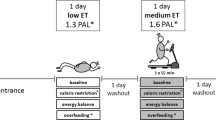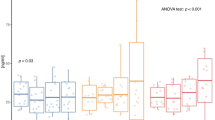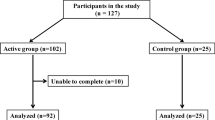Abstract
OBJECTIVE: Two studies were conducted to assess the potential of an increase in exercise intensity to alter energy and lipid metabolism and body fatness under conditions mimicking real life.
METHODS: Study 1 was based on the comparison of adiposity markers obtained in 352 male healthy adults who participated in the Québec Family Study who either regularly participated in high-intensity physical activities or did not. Study 2 was designed to determine the effects of high-intensity exercise on post-exercise post-prandial energy and lipid metabolism as well as the contribution of β-adrenergic stimulation to such differences under a real-life setting.
RESULTS: Results from Study 1 showed that men who regularly take part in intense physical activities display lower fat percentage and subcutaneous adiposity than men who never perform such activities, and this was true even if the latter group reported a lower energy intake (917 kJ/day, P<0.05). In Study 2, the high-intensity exercise stimulus produced a greater post-exercise post-prandial oxygen consumption as well as fat oxidation than the resting session, an effect which disappeared with the addition of propranolol. In addition, the increase in post-prandial oxygen consumption observed after the high-intensity exercise session was also significantly greater than that promoted by the low-intensity exercise session.
CONCLUSION: These results suggest that high-intensity exercise favors a lesser body fat deposition which might be related to an increase in post-exercise energy metabolism that is mediated by β-adrenergic stimulation.
This is a preview of subscription content, access via your institution
Access options
Subscribe to this journal
Receive 12 print issues and online access
$259.00 per year
only $21.58 per issue
Buy this article
- Purchase on Springer Link
- Instant access to full article PDF
Prices may be subject to local taxes which are calculated during checkout



Similar content being viewed by others
References
Dionne I, White M, Tremblay A . Acute effects of exercise and low-fat diet on energy balance in heavy men Int J Obes Relat Metab Disord 1997 21: 413–416.
Tremblay A, Alméras N, Boer J, Kranenbarg EK, Després JP . Diet composition and postexercise energy balance Am J Clin Nutr 1994 59: 975–979.
King NA, Blundell JE . High-fat foods overcome the energy expenditure due to exercise after cycling and running Eur J Clin Nutr 1995 49: 114–123.
Imbeault P, Saint-Pierre S, Almeras N, Tremblay A . Acute effects of exercise on energy intake and feeding behaviour Br J Nutr 1997 77: 511–521.
Sedlock DA, Fissinger JA, Melby CL . Effect of exercise intensity and duration on postexercise energy expenditure Med Sci Sports Exerc 1989 21: 662–666.
Gore CJ, Wither RT . The effect of exercise intensity and duration on the oxygen deficit and excess post-exercise oxygen consumption Eur J Appl Physiol 1990 60: 169–174.
Bahr R, Sejersted OM . Effect of intensity of exercise on excess postexercise O2 consumption Metabolism 1991 40: 836–841.
Bielinski R, Schutz Y, Jequier E . Energy metabolism during the postexercise recovery in man Am J Clin Nutr 1985 42: 69–82.
Phelain JF, Reinke E, Harris MA, Melby CL . Postexercise energy expenditure and substrate oxidation in young women resulting from exercise bouts of different intensity J Am Coll Nutr 1997 16: 140–146.
van Baak MA . Exercise training and substrate utilisation in obesity Int J Obes Relat Metab Disord 1999 23 (Suppl 3): S11–17.
Thompson DL, Townsend KM, Boughey R, Patterson K, Bassett DR Jr . Substrate use during and following moderate- and low-intensity exercise: implications for weight control Eur J Appl Physiol 1998 78: 43–49.
Tremblay A, Després J-P, Leblanc C, Craig CL, Ferris B, Stephens T, Bouchard C . Effect of intensity of physical activity on body fatness and fat distribution Am J Clin Nutr 1990 51: 153–157.
Tremblay A, Simoneau J-A, Bouchard C . Impact of exercise intensity on body fatness and skeletal muscle metabolism Metabolism 1994 43: 814–818.
Doucet E, Imbeault P, Almeras N, Tremblay A . Physical activity and low-fat diet: is it enough to maintain weight stability in the reduced-obese individual following weight loss by drug therapy and energy restriction? Obes Res 1999 7: 323–333.
McGuire MT, Wing RR, Klem ML, Seagle HM, Hill JO . Long-term maintenance of weight loss: do people who lose weight through various weight loss methods use different behaviors to maintain their weight? Int J Obes Relat Metab Disord 1998 22: 572–577.
Tremblay A, Buemann B, Thériault G, Bouchard C . Body fatness in active individuals reporting low lipid and alcohol intake Eur J Clin Nutr 1995 49: 824–831.
The Canadian Nutrient File Health and Welfare Canada 1991.
Tremblay A, Sévigny J, Leblanc C, Bouchard C . The reproducibility of a three-day dietary record Nutr Res 1983 3: 819–830.
Bouchard C, Tremblay A, Leblanc C, Lortie G, Savard R, Thériault G . A method to assess energy expenditure in children and adults Am J Clin Nutr 1983 37: 461–467.
Weiner JS, Lourie LA . Human biology: a guide to field methods Oxford: Blackwell Scientific 1969.
Behnke AR, Wilmore JH . Evaluation and regulation of body build and composition. Englewood Cliffs, NJ: Prentice-Hall 1974 pp 20–37.
Siri WE . The gross composition of the body Adv Biol Med Physiol 1956 4: 239–280.
Meneely EA, Kaltreider NL . Volume of the lung determined by helium dilution J Clin Invest 1949 28: 129–139.
Prud'Homme D, Bouchard C, Leblanc C, Landry F, Lortie G, Boulay MR . Reliability of assessments of ventilatory thresholds J Sports Sci 1984 2: 13–24.
Lusk G . The elements of the science of nutrition London: Saunders 1931 pp 61–74.
Dionne I, Almeras N, Bouchard C, Tremblay A . The association between vigorous physical activities and fat deposition in male adolescents Med Sci Sports Exerc 2000 32: 392–395.
Poehlman ET, Danforth E . Endurance training increases metabolic rate and norepinephrine appearance rate in older individuals Am J Physiol 1991 261: E233–E239.
Tremblay A, Coveney JP, Després JP, Nadeau A, Prud'homme D . Increased resting metabolic rate and lipid oxidation in exercise-trained individuals: evidence for a role of beta adrenergic stimulation Can J Physiol Phamac 1992 70: 1342–1347.
Calles-Escandon J, Goran MI, O' Connell M, Spreekumaran K, Danforth E . Exercise increases fat oxidation at rest unrelated to changes in energy balance or lipolysis Am J Physiol 1996 270: E1009–E1014.
Poehlman ET, Gardner AW, Arciero PJ, Goran MI, Calles-Escandon J . Effects of endurance training on total fat oxidation in elderly persons J Appl Physiol 1994 76: 2281–2287.
Goran MI, Poehlman ET . Endurance training does not enhance total energy expenditure in healthy elderly persons Am J Physiol 1992 263: E950–E957.
Sjodin AM, Forslund AH, Westerterp KR, Andersson AB, Forslund JM, Hambraeus LM . The influence of physical activity on BMR Med Sci Sports Exerc 1996 28: 85–91.
Westerterp KR, Meijer GA, Janssen EM, Saris WH, Ten Hoor F . Long-term effect of physical activity on energy balance and body composition Br J Nutr 1992 68: 21–30.
Blaak EE, Westerterp KR, Bar-Or O, Wouters LJ, Saris WH . Total energy expenditure and spontaneous activity in relation to training in obese boys Am J Clin Nutr 1992 55: 777–782.
Bahr R, Ingnes I, Vaage O, Sejersted OM, Newsholme EA . Effect of duration of exercise on excess postexercise O2 consumption J Appl Physiol 1987 62: 485–490.
Groop LC, Bonadonna RC, Shank M, Petrides AS, DeFronzo RA . Role of free fatty acids and insulin in determining free fatty acid and lipid oxidation in man J Clin Invest 1991 87: 83–89.
Groop LC, Bonadonna RC, Simonson DC, Petrides AS, Shank M, DeFronzo RA . Effect of insulin on oxidative and nonoxidative pathways of free fatty acid metabolism in human obesity Am J Physiol 1992 263: E79–E84.
Wennlund A, Wahrenberg H, Hagstrom-Toft E, Bolinder J, Arner P . Lipolytic and cardiac responses to various forms of stress in humans Int J Sports Med 1994 15: 408–413.
Leuenberger U, Sinoway L, Gubin S, Gaul L, Davis D, Zelis R . Effects of exercise intensity and duration on norepinephrine spillover and clearance in humans J Appl Physiol 1993 75: 668–674.
Schrauwen P, Lichtenbelt WD, Saris WH, Westerterp KR . Fat balance in obese subjects: role of glycogen stores Am J Physiol 1998 274: E1027–1033.
Coyle EF, Jeukendrup AE, Wagenmakers AJ, Saris WH . Fatty acid oxidation is directly regulated by carbohydrate metabolism during exercise Am J Physiol 1997 273: E268–275.
Dionnel, Van Vugt S, Tremblay A . Postexercise macronutrient oxidation: a factor dependent on postexercise macronutrient intake Am J Clin Nutr 1999 69: 927–930.
Acknowledgements
The authors thank Rachel Duchesne, Marie Martin, Jacques Renaud, and Henri Bessette for their technical assistance. Study 2 was supported by the Natural Sciences and Engineering Research Council of Canada.
Author information
Authors and Affiliations
Corresponding author
Rights and permissions
About this article
Cite this article
Yoshioka, M., Doucet, E., St-Pierre, S. et al. Impact of high-intensity exercise on energy expenditure, lipid oxidation and body fatness. Int J Obes 25, 332–339 (2001). https://doi.org/10.1038/sj.ijo.0801554
Received:
Revised:
Accepted:
Published:
Issue Date:
DOI: https://doi.org/10.1038/sj.ijo.0801554
Keywords
This article is cited by
-
Effect of diet with or without exercise on abdominal fat in postmenopausal women – a randomised trial
BMC Public Health (2019)
-
Associations of physical activity and sedentary time with body composition in Brazilian young adults
Scientific Reports (2019)
-
Physical activity throughout adolescence and body composition at 18 years: 1993 Pelotas (Brazil) birth cohort study
International Journal of Behavioral Nutrition and Physical Activity (2016)
-
The use of metabolomics to monitor simultaneous changes in metabolic variables following supramaximal low volume high intensity exercise
Metabolomics (2016)
-
Moderate and Vigorous Intensity Exercise During Pregnancy and Gestational Weight Gain in Women with Gestational Diabetes
Maternal and Child Health Journal (2016)



